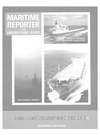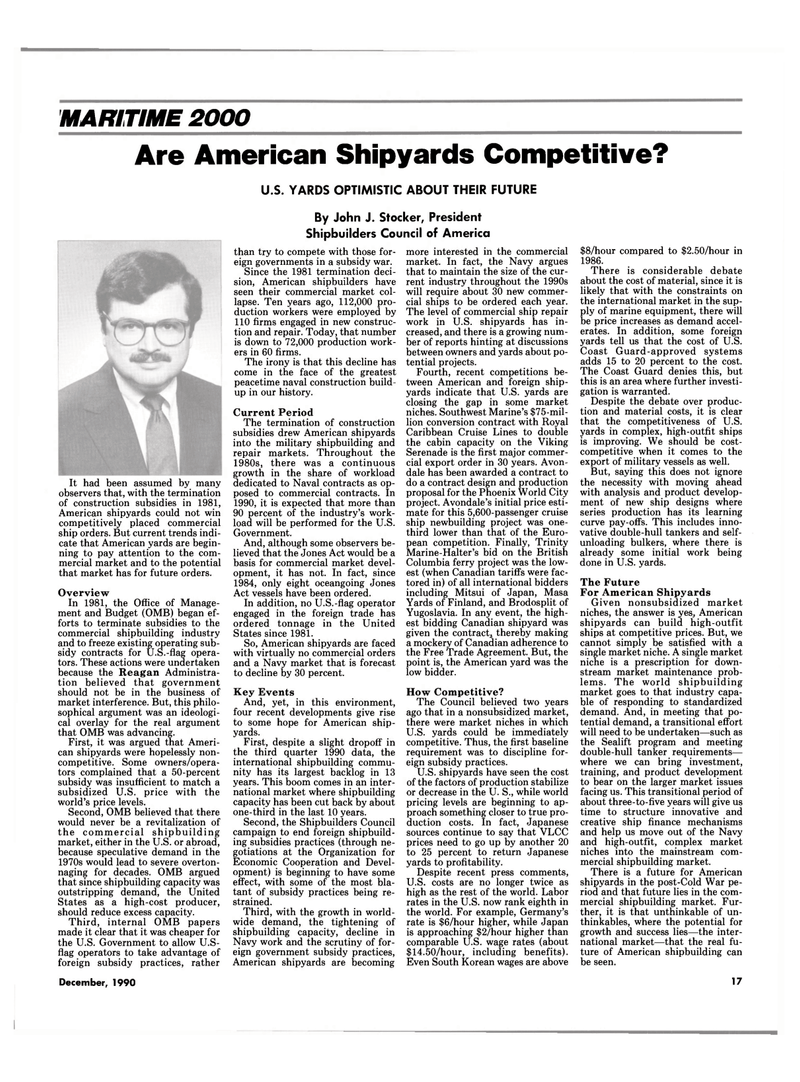
Page 15: of Maritime Reporter Magazine (December 1990)
Read this page in Pdf, Flash or Html5 edition of December 1990 Maritime Reporter Magazine
MARITIME 2000
Are American Shipyards Competitive?
U.S. YARDS OPTIMISTIC ABOUT THEIR FUTURE
By John J. Stocker, President
Shipbuilders Council of America
It had been assumed by many observers that, with the termination of construction subsidies in 1981,
American shipyards could not win competitively placed commercial ship orders. But current trends indi- cate that American yards are begin- ning to pay attention to the com- mercial market and to the potential that market has for future orders.
Overview
In 1981, the Office of Manage- ment and Budget (OMB) began ef- forts to terminate subsidies to the commercial shipbuilding industry and to freeze existing operating sub- sidy contracts for U.S.-flag opera- tors. These actions were undertaken because the Reagan Administra- tion believed that government should not be in the business of market interference. But, this philo- sophical argument was an ideologi- cal overlay for the real argument that OMB was advancing.
First, it was argued that Ameri- can shipyards were hopelessly non- competitive. Some owners/opera- tors complained that a 50-percent subsidy was insufficient to match a subsidized U.S. price with the world's price levels.
Second, OMB believed that there would never be a revitalization of the commercial shipbuilding market, either in the U.S. or abroad, because speculative demand in the 1970s would lead to severe overton- naging for decades. OMB argued that since shipbuilding capacity was outstripping demand, the United
States as a high-cost producer, should reduce excess capacity.
Third, internal OMB papers made it clear that it was cheaper for the U.S. Government to allow U.S- flag operators to take advantage of foreign subsidy practices, rather than try to compete with those for- eign governments in a subsidy war.
Since the 1981 termination deci- sion, American shipbuilders have seen their commercial market col- lapse. Ten years ago, 112,000 pro- duction workers were employed by 110 firms engaged in new construc- tion and repair. Today, that number is down to 72,000 production work- ers in 60 firms.
The irony is that this decline has come in the face of the greatest peacetime naval construction build- up in our history.
Current Period
The termination of construction subsidies drew American shipyards into the military shipbuilding and repair markets. Throughout the 1980s, there was a continuous growth in the share of workload dedicated to Naval contracts as op- posed to commercial contracts. In 1990, it is expected that more than 90 percent of the industry's work- load will be performed for the U.S.
Government.
And, although some observers be- lieved that the Jones Act would be a basis for commercial market devel- opment, it has not. In fact, since 1984, only eight oceangoing Jones
Act vessels have been ordered.
In addition, no U.S.-flag operator engaged in the foreign trade has ordered tonnage in the United
States since 1981.
So, American shipyards are faced with virtually no commercial orders and a Navy market that is forecast to decline by 30 percent.
Key Events
And, yet, in this environment, four recent developments give rise to some hope for American ship- yards.
First, despite a slight dropoff in the third quarter 1990 data, the international shipbuilding commu- nity has its largest backlog in 13 years. This boom comes in an inter- national market where shipbuilding capacity has been cut back by about one-third in the last 10 years.
Second, the Shipbuilders Council campaign to end foreign shipbuild- ing subsidies practices (through ne- gotiations at the Organization for
Economic Cooperation and Devel- opment) is beginning to have some effect, with some of the most bla- tant of subsidy practices being re- strained.
Third, with the growth in world- wide demand, the tightening of shipbuilding capacity, decline in
Navy work and the scrutiny of for- eign government subsidy practices,
American shipyards are becoming more interested in the commercial market. In fact, the Navy argues that to maintain the size of the cur- rent industry throughout the 1990s will require about 30 new commer- cial ships to be ordered each year.
The level of commercial ship repair work in U.S. shipyards has in- creased, and there is a growing num- ber of reports hinting at discussions between owners and yards about po- tential projects.
Fourth, recent competitions be- tween American and foreign ship- yards indicate that U.S. yards are closing the gap in some market niches. Southwest Marine's $75-mil- lion conversion contract with Royal
Caribbean Cruise Lines to double the cabin capacity on the Viking
Serenade is the first major commer- cial export order in 30 years. Avon- dale has been awarded a contract to do a contract design and production proposal for the Phoenix World City project. Avondale's initial price esti- mate for this 5,600-passenger cruise ship newbuilding project was one- third lower than that of the Euro- pean competition. Finally, Trinity
Marine-Halter's bid on the British
Columbia ferry project was the low- est (when Canadian tariffs were fac- tored in) of all international bidders including Mitsui of Japan, Masa
Yards of Finland, and Brodosplit of
Yugoslavia. In any event, the high- est bidding Canadian shipyard was given the contract, thereby making a mockery of Canadian adherence to the Free Trade Agreement. But, the point is, the American yard was the low bidder.
How Competitive?
The Council believed two years ago that in a nonsubsidized market, there were market niches in which
U.S. yards could be immediately competitive. Thus, the first baseline requirement was to discipline for- eign subsidy practices.
U.S. shipyards have seen the cost of the factors of production stabilize or decrease in the U. S., while world pricing levels are beginning to ap- proach something closer to true pro- duction costs. In fact, Japanese sources continue to say that VLCC prices need to go up by another 20 to 25 percent to return Japanese yards to profitability.
Despite recent press comments,
U.S. costs are no longer twice as high as the rest of the world. Labor rates in the U.S. now rank eighth in the world. For example, Germany's rate is $6/hour higher, while Japan is approaching $2/hour higher than comparable U.S. wage rates (about $14.50/hour, including benefits).
Even South Korean wages are above $8/hour compared to $2.50/hour in 1986.
There is considerable debate about the cost of material, since it is likely that with the constraints on the international market in the sup- ply of marine equipment, there will be price increases as demand accel- erates. In addition, some foreign yards tell us that the cost of U.S.
Coast Guard-approved systems adds 15 to 20 percent to the cost.
The Coast Guard denies this, but this is an area where further investi- gation is warranted.
Despite the debate over produc- tion and material costs, it is clear that the competitiveness of U.S. yards in complex, high-outfit ships is improving. We should be cost- competitive when it comes to the export of military vessels as well.
But, saying this does not ignore the necessity with moving ahead with analysis and product develop- ment of new ship designs where series production has its learning curve pay-offs. This includes inno- vative double-hull tankers and self- unloading bulkers, where there is already some initial work being done in U.S. yards.
The Future
For American Shipyards
Given nonsubsidized market niches, the answer is yes, American shipyards can build high-outfit ships at competitive prices. But, we cannot simply be satisfied with a single market niche. A single market niche is a prescription for down- stream market maintenance prob- lems. The world shipbuilding market goes to that industry capa- ble of responding to standardized demand. And, in meeting that po- tential demand, a transitional effort will need to be undertaken—such as the Sealift program and meeting double-hull tanker requirements— where we can bring investment, training, and product development to bear on the larger market issues facing us. This transitional period of about three-to-five years will give us time to structure innovative and creative ship finance mechanisms and help us move out of the Navy and high-outfit, complex market niches into the mainstream com- mercial shipbuilding market.
There is a future for American shipyards in the post-Cold War pe- riod and that future lies in the com- mercial shipbuilding market. Fur- ther, it is that unthinkable of un- thinkables, where the potential for growth and success lies—the inter- national market—that the real fu- ture of American shipbuilding can be seen.
December, 1990 17

 14
14

 16
16
